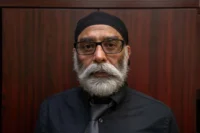Ram Singh, played by Dilip Kumar, enters a rural landlord’s home where an occult ritual is being performed to treat a plague-stricken child.
“Main munne ko aspatal le jaane aaya hoon,” he announces, disrupting the ritual. I have come to take the child to the hospital.
In the next frame, we see Singh admonishing Sushma, played by Nalini Jaywant, for delaying her son’s treatment and relying on occult care. “Jahil, apni akalmandi ka nateeza dekh rahi ho?” Ignorant, are you seeing the result of your smartness?
In the 1953 Dilip Kumar-Nalini Jaywant starrer Shikast, the exchange is set in Kundan Garh, a village ravaged by the plague epidemic. The local hospital is rapidly filled with infected patients. The film’s director Ramesh Saigal uses the epidemic as a 10-minute subplot to push the multi-layered story. In the process, the film became one of the very few works in Hindi cinema where an epidemic has found a place in the narrative, even if it isn’t central to the story.
Shikast, which literally means defeat, could not win box office approval. Even in retrospect, it has gone largely unnoticed in Dilip Kumar’s filmography. That’s despite the fact that it was the last of the only two films that Dilip Kumar did with Jaywant, an actress he rated very highly for her craft. However, in a world grappling with a new pandemic, the film can be revisited for a very different reason: it’s one of the very few Hindi films to have woven the scourge of an epidemic into the larger canvas of storytelling. In a strange way, Shikast has been denied its due and attention even in this shortest of lists.
The use of the epidemic is as much a plot device as it is a polemical instrument in the film. Ramesh Saigal has been known for speaking his left-leaning mind in his work, as evidenced in his later films like Phir Subah Hogi (1958). In Shikast, he uses the plight of a landless peasant Manglu and his daughter Sundariya, a domestic worker at a landlady’s home, to convey the class divide seen in the epidemic-inflicted scourge. As different facets of the Covid-19 pandemic unfolded over the past year, two scenes are worth recalling.
First, when Manglu requests that Sundariya be relieved of her service because someone is plague-stricken in her employer’s house. The recognition of equal needs of domestic workers and their employers to be protected from disease, or the need for employers to share information about their infection, is a question which surfaced in discussions around the class dimensions of Covid behaviour in recent times. The film positions it in a rural setting and feudal work space. Manglu’s plea is summarily rejected and he is shown too powerless to protest. It’s only after being infected with the plague herself that Sundariya is forced out of the house. She dies while being treated by Ram Singh in the village hospital.
As Manglu mourns his daughter’s death, he juxtaposes her fate with that of the landlady’s son, who is also infected. However, as mentioned earlier, if Manglu’s poverty claimed his daughter, the landlady family’s ignorance came in the way of her son’s treatment. Far from seeking medical help, his treatment is held hostage to superstition. As the story unfolds, he is rescued and treated by the leading man of the film. In a story with many strands, it’s useful that the leading man is a doctor as well as a landowner, an evolving reformer, and forlorn and brooding lover trying to make bridges with the lost love of his childhood.






